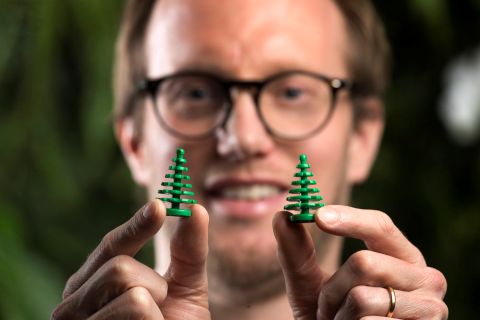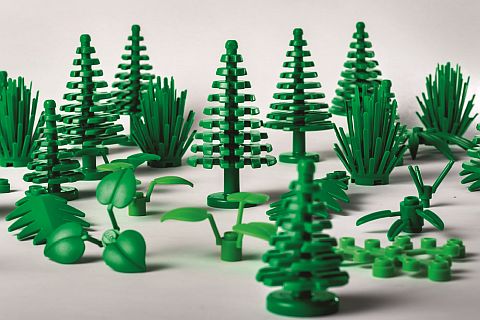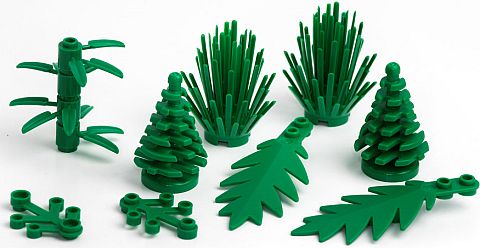A few days ago, LEGO announced in a press-release, that their botanical elements – such as leaves, bushes and trees – will be made from plant-based plastic sourced from sugarcane. The new pieces will appear in LEGO boxes as early as this year. The move is part of the LEGO Group’s commitment to use sustainable materials in core products and packaging by 2030. Below are the details. 🙂

Production has started on a range of sustainable LEGO elements made from plant-based plastic sourced from sugarcane. The new sustainable LEGO ‘botanical’ elements will come in varieties including leaves, bushes and trees.
“At the LEGO Group we want to make a positive impact on the world around us, and are working hard to make great play products for children using sustainable materials. We are proud that the first LEGO elements made from sustainably sourced plastic are in production and will be in LEGO boxes this year. This is a great first step in our ambitious commitment of making all LEGO bricks using sustainable materials,” said Tim Brooks, Vice President, Environmental Responsibility at the LEGO Group.

The new sustainable LEGO elements are made from polyethylene, which is a soft, durable and flexible plastic, and while they are based on sugar-cane material, they are technically identical to those produced using conventional plastic. The elements have been tested to ensure the plant-based plastic meets the high standards for quality and safety that the LEGO Group has, and consumers expect from LEGO products.
“LEGO products have always been about providing high quality play experiences giving every child the chance to shape their own world through inventive play. Children and parents will not notice any difference in the quality or appearance of the new elements, because plant-based polyethylene has the same properties as conventional polyethylene,” said Tim Brooks.

The unique LEGO brick design, and the LEGO Group’s uncompromised focus on quality and safety during the past 60 years ensures that two LEGO bricks produced decades apart can still fit together. As the LEGO Group is working towards using sustainable materials in its core products and packaging, it will remain strongly rooted and driven by the uncompromised focus on high product quality and safety.
The LEGO Group has partnered with WWF to support and build demand for sustainably sourced plastic, and has joined the Bioplastic Feedstock Alliance (BFA), an initiative of WWF, to secure fully sustainable sourcing of raw material for the bioplastics industry. The plant-based plastic used to make the botanical LEGO elements is certified by the Bonsucro Chain of Custody standard for responsibly sourced sugarcane.
“It is essential that companies in each industry find ways to responsibly source their product materials and help ensure a future where people, nature, and the economy thrive,” said Alix Grabowski, a senior program officer at WWF. “The LEGO Group’s decision to pursue sustainably sourced bio-based plastics represents an incredible opportunity to reduce dependence on finite resources, and their work with the Bioplastic Feedstock Alliance will allow them to connect with other companies to continue to think creatively about sustainability.”
It is also interesting to note from the press-release that currently there is no common definition of what a sustainable material is, but there are several aspects that influence what material is considered sustainable. To a high degree, it is determined by the material’s source, chemical composition, its use (in a product) and management (at end-of-life), and the impact it can have in both environmental and social areas. The LEGO Group believes a new sustainable material must have an ever-lighter footprint than the material it replaces across key environmental and social impact areas such as fossil resource use, human rights and climate change.
LEGO has been making significant efforts to be as eco-friendly as possible. Through investments in wind power, the energy used to make LEGO bricks is balanced by the production of renewable energy. They also regularly tweak their packaging to be more eco-friendly; like introducing sustainable paper pulp trays for the LEGO advent calendars, reducing plastic waste from going to landfill. And they targeted 2030 to reach zero waste in operations.

I’m very curious to try out the new sugarcane plants! Are they going to be sweet? Just kidding… The press-release indicates that we shouldn’t notice any difference, but still, I want to put that to the test. Durability and longevity are very important considerations when it comes to LEGO pieces. They have to be able to survive the rough play of children, and the erosive power of natural elements and time. I’m also wondering what other elements LEGO is going to be working on next! Makes me both nervous and excited for the future of LEGO bricks!
What do you think? How do you like the sugarcane plants and the idea of making LEGO bricks more sustainable? Do you have any comments, questions, concerns about the process? Feel free to share your thoughts and discuss in the comment section below! 😉
And you might also like to check out the following related posts:












I’m curious about the longterm life of these. The stability of the plastic itself, colorfastness, its interaction with the environment (heat, light, etc.), and whether they stretch with time. Good thing they are only doing the plants right now, where the clutch power is not as crucial.
Way to go Lego! This is the other reason why I love Lego . They are not just about Business and making money. It’s about the environment as well . The fact that Lego has taken the time to do this is great. They have my most highest respect. Two thumbs way, way up.
I agree. And they are planning to do even more. They are definitely a leader in the plastic using industry. Of course, they have to do it, because their whole existence is based on plastic. If certain plastics they currently use get outlawed, they are in big trouble. So, it’s best to be proactive and look ahead.
You don’t think this is about making money through politics instead of through business? Ethanol in the gasoline is a massive boondoggle.
I wonder if this plastic was tried in other industries, and they may already have some data about things like the stability and colorfastness of the material. Otherwise we will have to wait to see how well these new plant pieces perform long term.
So, are they going to do other colors too? Or only doing green at this time? Will it be announced which sets will have the new parts? And will they say that on the box? Sorry, so many questions. I’m both excited and nervous about this.
Well, they’re botanical elements, but I don’t think the color itself is much of an issue…
Lego Elves have some botanical pieces in magenta, dark red, and lavender for example.
I read something that many botanical parts were made in some other plastic than ABS already (which might be more supple and bendy). That might have played a part in the decision, apart from the symbolical value.
I fail to see how green would be particularly easier to produce than other common colors, though.
Not sure, but I would say it would make sense from the marketing point of view to advertise that some of the parts are eco-friendly. No further details on this besides what I shared here, but we may know more later.
Kudos to Lego for doing this. I just hope that quality remains the same.
I’d like to see them move toward something greener for their tires. It shouldn’t impact most kids or builders but would potentially save a lot of rubber from having to be made.
Would rubber be more detrimental to manufacture than plastic?